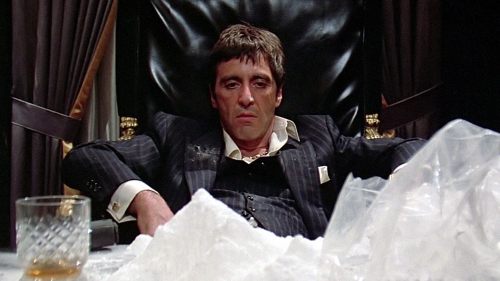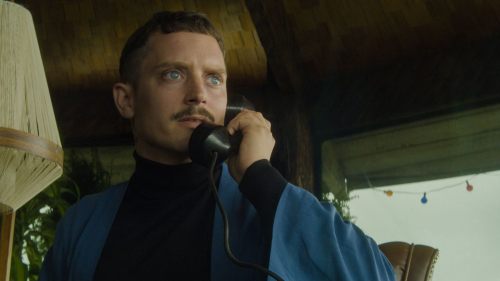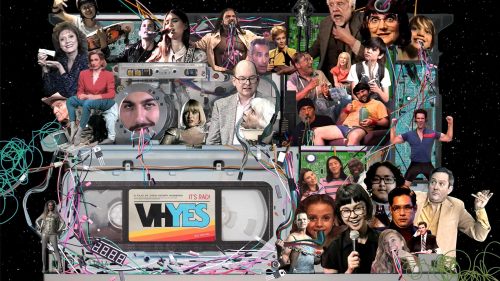Fantastic Fest Review: SUSPIRIA Is A Revolutionary New Dance
Note: The following contains what may be considered mild spoilers for Suspiria.
1977. Lufthansa Flight 181 is hijacked on October 13th by four members of the Popular Front for the Liberation of Palestine (labeling themselves the Commando Martyr Halima). Their objective: to secure the release of imprisoned Red Army Faction leaders, a West German far-left militant organization founded in 1970 (which was also known by many as the "Baader-Meinhoff Gang"). This revolutionary attack is considered part of the German Autumn: a national predicament in which the RAF engaged in a series of bombings, assassinations, kidnappings, bank robberies and shoot-outs with police. These acts resulted in multiple deaths, as the terrorist group waged war against the West German government in the name of politics originally derived from student protest groups who raged against racism, upheld women's liberation, and were deeply suspicious of the reigning class. Ultimately, the hijacking failed, as rescuers escorted all 86 passengers safely off the aircraft. News of the hostages' recovery was quickly followed by the deaths of RAF members Andreas Baader, Gudrun Ensslin, and Jan-Carl Raspe.
1977. Former film critic-cum-gialli maestro Dario Argento grows bored with the black-gloved killers he helped perfect in the wake of Mario Bava's The Girl Who Knew Too Much ('63), a picture that ushered in a wave of popular Italian murder mysteries. After traveling through Europe, Argento co-writes Suspiria with frequent collaborator Daria Nicolodi, based in part on Thomas De Quincey's 1845 essay Suspiria de Profundis, which accented the horror stylist’s previous fascination with the European "Magic Triangle". The Triangle is where the countries of France, Germany, and Switzerland meet, and social reformer Rudolf Steiner formed his own anthroposophical society, hoping to help others spiritually heal through inner development. A dark, primary color-saturated fairy tale, Suspiria follows ballerina Suzy Bannion (famously played by Jessica Harper) as she enrolls in a Berlin dance academy that acts as a front for a coven of witches. Combining Dario's (in)famous murder set pieces with dream logic derived from actual nightmares Nicolodi suffered while staying in Los Angeles, the resulting film became (and remains) one of the finest works in scare cinema.
While these parallel historical and filmic elements may seem wildly disparate and unrelated, they actually combine for writer/director Luca Guadagnino's (Call Me By Your Name ['17]) radical redux of Argento's classic. Not simply content to reconstruct the gorgeously colorful slasher-ready kill sequences, Guadagnino’s instead opted to craft a pensive, near-three-hour (or, six acts and an epilogue) examination of revolution, and its natural place within not only humanity, but the planet's life cycle. The ancient "Three Mothers" that Argento invented* - based mostly around the "Levana and Our Ladies of Sorrow" portion of De Quincey's impassioned prose - are, in Guadagnino's hands, no different than any other ruling class. It's the arrival of Suzy Bannion - played here by Fifty Shades trilogy refugee Dakota Johnson (who absolutely killed it as the sexpot in Guadagnino's A Bigger Splash ['15] make over) - that throws this established house into discord, Snow White becoming a new twirling icon for upheaval.
As brilliant as the original Suspiria is, Suzy Bannion wasn't much of a character. Like many of Argento's gorgeous women in danger, the dancer was more of a "type", leading us through the dangers of her newfound dungeon of learning like Alice down the rabbit hole. Screenwriter David Kajganich - whose own pulp bona fides can be verified via the bonkers, underseen Michael Fassbender-led undead Nazi romp, Blood Creek ('09) - transforms Suzy into her own rebel, fleeing from a Mennonite** upbringing in Ohio. Leaving behind a dying mother who (accoding to a rather strategically placed crochet sign) we learn "cannot be replaced", Suzy dreams of becoming a regular player in the troupe led by Madame Blanc (Tilda Swinton), whom the girl hitchhiked across the country to see perform in New York on more than one occasion.
Upon initially auditioning for the company in '77, Suzy is forced to dance without the aid of music, and it's the first moment where we get a chance to witness just how riveting and physical Johnson's performance as Bannion truly is. Guadagnino has always been a director in love with the way our bodies move and express themselves in rhythm, and Johnson twists, turns and throws herself, as the director's camera stays high, wide and steady. After Madame Blanc takes Suzy under her wing - following a seemingly innocuous democratic vote regarding whom the company should trust as their next lead - she instructs her new pupil to "break the nose of everything beautiful". Suddenly, every rehearsal is centered around Suzy, as she improvises and thrashes about, Johnson's body becoming a blunt, expressive instrument of rebellion, shedding years of religious repression before our eyes. This is what revolution looks like when filtered through personal art, and the actress perfectly captures the divine bliss that accompanies her form being set free for the first time in her life.
One of Luca's greatest collaborators is (and, one suspects always will be) Swinton, whose turns as the unfulfilled textile matriarch in I Am Love ('09) and the vocally fried rock star in A Bigger Splash are some of the finest performances of her complex, brilliant career. In Suspiria, Guadagnino gifts her not one, not two, but three separate roles to fill in the picture. The first is Madame Blanc - whom Swinton instills with a still strangeness that's just the right level of ominous. The second (under the alias Lutz Ebersdorf) is Dr. Jozef Klemperer - a Jungian psychologist and holocaust survivor who’s drawn to the dance troupe after one of its members (Chloë Grace Moretz) escapes and warns him of the evil it hides. The third will go unnamed, as to reveal it would do the viewer a grand disservice. Just know that, per usual, Swinton is utterly magnetic in each role, disappearing beneath layers of latex only to emerge with fully formed human beings, filled with terror, desire, sin and regret that they will all express by the time this iteration of Suspiria reaches its brief, melancholy coda.
Guadagnino's pictures have always been rooted in classical Italian cinema - namely Vittorio De Sica and Michelangelo Antonioni - yet this is the first time it feels like the Palermo-born auteur is tipping his cinematic cap toward his motherland’s deep horror and exploitation roots. Regular Apichatpong Weerasethakul cinematographer Sayombhu Mukdeeprom (Uncle Boonmee Who Can Recall His Past Lives ['10]) pulls from the muted browns, greys and deep blacks that made up the filmography of notorious gore whizz Lucio Fulci (Zombie ['79]), while simultaneously replicating the late '70s Berlin of Rainer Werner Fassbinder (whose filmography might be this work's greatest influence). Gone is the sun-splashed loveliness of Call Me By Your Name (which Mukdeeprom also lensed), replaced with the drab texture of a country under siege. Production designer Inbal Weinberg (Three Billboards Outside Ebbing, Missouri ['17]) replicates the engulfing expressionism of the architecture found in Argento's original picture, but then transplants it into a rainy, tortured shell of Germany. Even where art is created in this fantastical vision of history, there is no vibrant joy to be found.
Discordant music was key to the original Suspiria's aesthetic. Only, instead of the bombastic prog rock of Argento's house band Goblin - who provided the scores for the majority of his macabre motion pictures - Radiohead's Thom Yorke is employed by Guadagnino to add a disorienting sonic texture to his take’s proceedings. A few of the tracks Yorke penned for Suspiria resemble his solo output: compositions comprised of simply a piano and his ethereal voice that become disorienting and anachronistic thanks to the movie's period setting. When the movie continues to descend into darkness, Yorke utilizes an atonal organ to thoroughly unsettle the audience, pulling you into the ambiance of these nasty witches' rituals before throwing you off-center with a perfectly placed note. Just as Guadagnino is keeping the bones of Suspiria's narrative intact while executing his own vision, hiring Yorke is a genius way to pay tribute to the idiosyncratic (not to mention iconic) horror soundtracks Argento fancied, while distinctly doing his own thing.
Of course, Suspiria wouldn't be Suspiria if it didn't contain a heap of upsetting imagery. While there aren't any "set pieces" contained within Luca's redux (at least, not in the classic gialli sense), the filmmaker still exercises a rather deft understanding of spooky moments that are again derived from the fundamental components of Argento's brilliant original. Girls running down dark hallways. Otherworldly beings emerging from blackness. Fractured reflections in mirrors. Ghostly whisperings. Tossed into the mix are new demons, such as amputees crawling across floors and reaching out toward our favorite dancer. Though his movie may be defiantly peculiar, Guadagnino has most definitely still delivered a horror remake that crawls under your skin, roots around, and then stays with you well after its appropriately splattery climax.
Perhaps "remake" is an incorrect term for what Guadagnino's done with his version of Suspiria. "Radical adaptation" actually seems more apt, as he treats Argento's movie as a source, filled with wonderful building blocks, and then uses those cinematic columns to support a structure built out of radio transmissions and paranoid fear, derived from the attacks happening outside of Madame Blanc's distinguished art house. In a sense, this is a rebirth; the director’s lens creating an entirely new all-timer, that more than earns the right to slap the name of Argento's defining masterwork in its opening credits. This new Suspiria is a dense, defiant, confrontational work of artistic terrorism, bubbling over with ideas that demand repeat viewings to unpack, like a torturous three-hour filmic nesting doll. Comparing the two will be inevitable, but enjoying both on their own terms will be a delight.
*And then later expanded upon in Suspiria sequels Inferno ('80) and Mother of Tears ('07).
**A religious order who experienced their own schism in 1693, when Jacob Ammann - a Swiss Anabaptist leader - felt that the church leaders were not holding to strict separation from the world and that spiritual renewal was needed. He split from the Swiss Brethren segment of the Anabaptists over this issue and his followers were nicknamed “Amish.”



